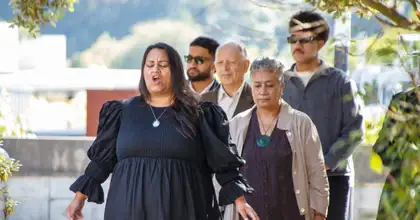
Background to pōwhiri
The word pōwhiri sums up two concepts that are important to Māori. According to Waitangi kaumātua (elder) Wiremu Williams, of the Ngā Puhi iwi:
- "pō" can be translated as a venture into the unknown, or a new experience
- "whiri" is derived from whiriwhiri, meaning the act or experience of exchanging information and knowledge.
While the customs of a pōwhiri can vary depending on region and iwi, the language used is always te reo Māori. We acknowledge the customs of our mana whenua (regional tribal group) for each campus when holding a pōwhiri.
Traditionally, the pōwhiri process was a way of seeing whether people were friends or enemies. We see that continue today in the way women enter and sit behind the men as a form of protection.
Structure of pōwhiri
Pōwhiri are about welcoming manuhiri (guests) onto a marae, or into a new workplace or other situation, by mana whenua.
The primal atua (gods) Papatūānuku (the earth mother) and Ranginui (the sky father) and their children are symbolised in the layout of the marae and its significance during pōwhiri.
The marae ātea, the space outside the front of the meeting house, is the domain of Tūmatauenga (or Tū), the god of war. Speeches that take place on the marae ātea are allowed to be forceful, representing the nature of Tū.
When pōwhiri happen in a non-marae space, the ātea is created by setting up chairs for the manuhiri and mana whenua across a space or divide. In this situation the seating layout is a critical part of the pōwhiri as the middle space represents the ātea.
Elements of a pōwhiri explained
When manuhiri arrive to attend a pōwhiri, they'll gather outside and wait to be called onto the marae by the mana whenua. Women stand at the back of the group, with men at the front.
The essential elements of a pōwhiri include the:
- karanga – a greeting call or incantation
- whaikōrero – formal speeches
- waiata – a song performed at the end of the whaikōrero to support what has been said
- hongi and harirū (shake hands) and hongi (press noses)
- kai – sharing food, which lifts the tāpu (sacredness) of the pōwhiri.
Get an explanation of each element of the pōwhiri
Etiquette
- Arrive early. It’s considered impolite to walk in once a pōwhiri is underway.
- Make sure cell phones are switched off throughout the pōwhiri.
- Do not walk in front of a speaker or through the space between the manuhiri and mana whenua (hosts).
- Men should lead the group and take the front seats, with women behind.
You can find out more about pōwhiri and get examples of karakia (incantation or prayers) and waiata in our cultural guidelines handbook.
Māori Cultural Handbook for Pōwhiri and Mihi Whakatau (472 KB)